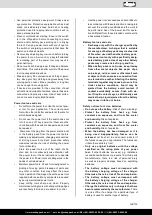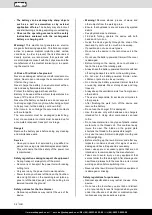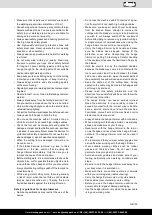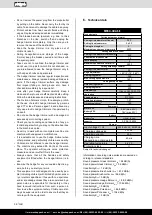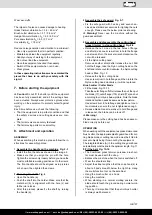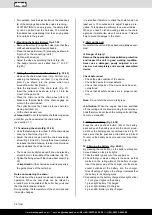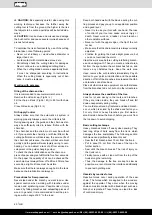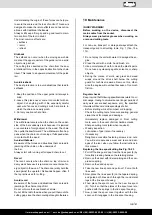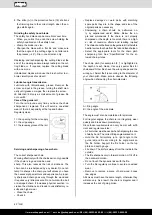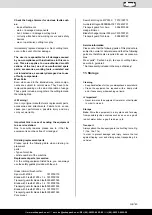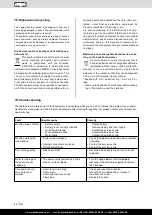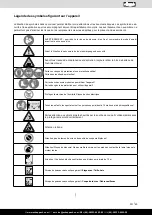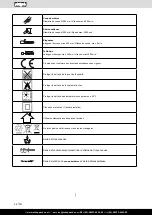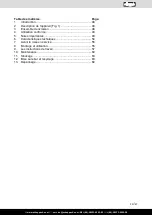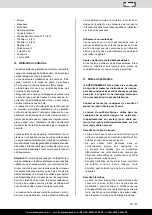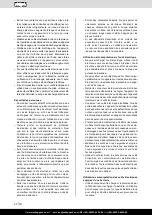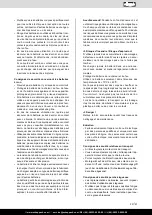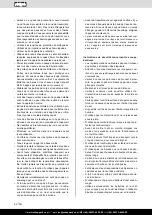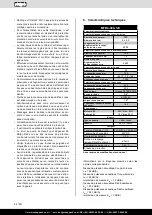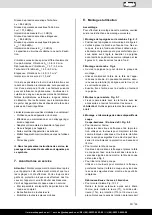
www.scheppach.com /
+(49)-08223-4002-99 /
+(49)-08223-4002-58
40 | GB
Keep both hands well with the device during the cut-
ting process and pay you up to an equilibrium position
and a good level.
• Never try to use your tool with one hand. The loss
of control of your tool can cause serious injury or
death. Never work on a ladder, a tree branch or
other unstable surfaces.
• Never cut with the upper edge or the tip of the cut-
ter bar.
• Make sure that the chain tension is always correctly
adjusted.
• Practice for guiding the device slight pressure, but
you do not overload the motor.
Clear the work area before cutting interfering branch-
es and undergrowth. Then you create a retreat area,
far from the spot where the cut branches fall on, and
remove any obstacles there. Keep the work area
clean, remove the cut branches immediately. Pay at-
tention to your point, wind direction and the possible
direction of fall of the branches. Be prepared that fall-
en branches can strike back.
Place all other tools and equipment at a safe distance
from the branches to be cut, but not in the retreat area.
Always observe the condition of the tree.
Look for rot and decay in the roots and branches.
If they are rotten inside, they can break off and fall
down unexpectedly during cutting.
You could also attend by fractured and dead branch-
es out, which is solved by the shake and fall on you.
For very thick or heavy branches you first make a
small incision below the branch before you work from
the top down to avoid chipping.
Basic cutting technique
Heavy branches break off easily when sawing. They
tear long strips of bark away from the trunk, which
damages the tree sustainably. The following section
technique can significantly reduce this risk:
•
Saw the first branch about 10 cm from the trunk.
• Put in about 15 cm from the base of the top of a
further section.
• Saw until the branch breaks. The risk of injury on
the trunk is no.
• Finally, remove with a clean cut from the top of the
trunk along the remaining.
• Thus, the damage to the tree are kept as low as
possible, we recommend the interface additionally
to seal with grafting wax.
Hazards by reactive forces
Reactive forces occur during operation of the saw
chain. The forces which are applied to the wood are
against the operator. They occur when the moving
chain comes into contact with a fixed object such as a
branch or is pinched. These forces can lead to a loss
of control and injury.
m
CAUTION:
Be especially careful, when using this
working technique, because the further away the
cutting tool is from the ground, the higher is the risk
that objects to be cut and particles will be hurled side-
ways.
m
CAUTION:
Incorrect use and misuse can damage
the bush cutter and cause severe injuries because of
pieces hurled away.
To minimize the risk of accidents by use of the cutting
blade, take note of following points:
• Never cut shrubbery or wood whose diameter is
larger than 2 cm.
• Avoid contact with metal bodies, stones, etc.
• Periodically check the cutting blade for damages.
Never continue to use a damaged cutting blade.
• When the cutting blade becomes apparently blunt,
it must be sharpened according to instructions.
When the cutting blade is apparently out of bal-
ance, it must be replaced.
Working with pole saw
Oiling of the chain and bar
It is recommended to use commercial chain oil.
Remove the oil tank cap. (Fig.34 / L)
Fill the chain oil tank (Fig.34 / M )) to 80% with chain
oil.
Close Oil tank cap (Fig.34 / L)
Oil Supply Control
Always make sure that the automatic oil system is
working properly. Always ensure the oil tank is full.
During sawing work, the guide and the chain must al-
ways be sufficiently oiled to reduce friction with the
chain bar.
The chain bar and the chain must never be without
oil. If you operate the chain dry or with too little oil, the
cutting performance will decrease, the service life of
the chain bar will reduce, the chain will become blunt
quickly and the guide will wear rapidly owing to over-
heating. You can detect a lack of oil from smoke de-
velopment or the guide changing colour.
To check the chain lubrication keep the chain on a
piece of paper and give full throttle for a few seconds.
On the paper the quantity of oil can be checked.The
saw chain must always throw off a little oil. After a few
seconds, a slight oil trace must be visible.
Make sure that there is always enough oil in the tank
because chain lubrication is always on.
Precautions for Saw procedure
Never stand under the branch you want to saw. Use
special caution when working with branches under
tension and splintering wood. Possible risk of injury
caused by falling branches and catapulting pieces of
wood. In general, it is recommended to set the prun-
ing saw at an angle of 60 ° to the road.








